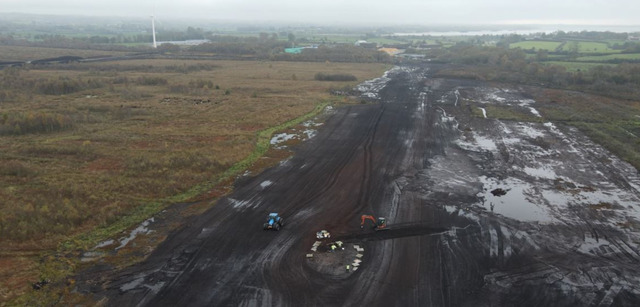In October 2023, a groundbreaking archaeological discovery was made in the tranquil peat bogs of Bellaghy, County Londonderry, Northern Ireland. Excavators working on routine peat extraction stumbled upon human remains, which, after detailed analysis, were revealed to belong to a young woman who lived more than 2,000 years ago. Initially thought to be a teenage boy, the discovery of the “Ballymacombs More Woman” has now turned the tide of historical understanding regarding Iron Age burials in Europe. This find has not only provided us with a glimpse into the past but also raised important questions about ritualistic practices and the role of women during the Iron Age.
Archaeological Context of the Find
The discovery of the remains was the result of a joint effort involving the Police Service of Northern Ireland’s Archaeological Unit, National Museums Northern Ireland (NI), Queen’s University Belfast, and several other prestigious academic institutions. The excavation initially began as a routine effort, with workers uncovering the body within the peat bog. What started as a typical archaeological dig quickly turned into a historic discovery.
The remains were quickly transferred to National Museums NI for further analysis, where specialists from various fields worked together to uncover the woman’s story. What followed was a year-long investigation, revealing both the physical attributes of the individual and a disturbing clue: evidence that suggested a violent death linked to a possible ritual sacrifice.


Video
Watch the video as police uncover a bog body dated over 2,000 years in Bellaghy – an incredible archaeological discovery!
The Physical Characteristics and Identity of the ‘Ballymacombs More Woman’
After conducting an osteoarchaeological analysis, experts concluded that the remains belonged to a young woman, aged between 17 and 22 years at the time of her death. Standing at 5 feet 6 inches, she was taller than many of her peers, as the average height for women in the Iron Age was generally shorter. This finding was significant because the majority of bog bodies discovered from this period have been male. The misidentification of the remains as a male in the early stages of the investigation raised questions about the gendered burial practices in ancient Europe.
Despite the woman’s well-preserved body, the skull was missing, and this absence of the head led to further investigation. Detailed forensic studies showed cut marks on the neck bones, indicating that decapitation was the cause of death. This finding pointed to the possibility that her death was not accidental, but rather part of a ritual sacrifice, a practice documented among ancient cultures but rarely confirmed through physical evidence.

Ritual Sacrifice Hypothesis
Ritual sacrifices in the Iron Age were not uncommon, with many cultures performing these rites to appease deities or to ensure agricultural fertility. Bog bodies, like those found across Europe, often show signs of violent deaths, such as stabbing, bludgeoning, hanging, or strangulation, which are believed to have been offerings to gods or used to symbolize the sovereignty of rulers. The discovery of the Ballymacombs More Woman has added weight to the theory that ritual sacrifice played a role in Iron Age society.
Archaeologists noted the lack of any traditional grave goods or treasures alongside the remains, which could suggest that the individual was sacrificed for a specific purpose rather than dying in a natural manner. The decapitation of the body, a violent act, could have been part of a larger, symbolic ritual that may have been intended to fulfill religious or cultural obligations. While there is no direct written evidence to confirm the ritual killing hypothesis, the pattern of violent deaths among other Iron Age bog bodies supports this theory.
Preservation and Analysis of the Remains
The role of peat bogs in the preservation of ancient remains cannot be understated. Peat bogs are anaerobic environments, meaning they lack oxygen, which helps to preserve organic materials such as wood, leather, and even human remains. The preservation of the Ballymacombs More Woman’s remains is a testament to the unique conditions of the bog. The bones, though missing the skull, showed remarkable preservation, with clothing and soft tissue remnants potentially being preserved further as the research continues.
The remains were subjected to a variety of forensic tests, with experts carefully analyzing every aspect of the find. One of the most significant discoveries was the woven item found near the remains. Made from plant material, this artifact is thought to have been an important part of the burial or ritual process. As of now, experts are working to determine the function of this artifact, though it is already considered an integral part of understanding the cultural practices of the time.

The Woven Artifact and Its Significance
In addition to the remains, archaeologists found a woven plant-based artifact located beneath the knees of the deceased. This item has piqued the interest of researchers, who are currently studying it to determine its role in the burial. Given its proximity to the body and its preservation, it is believed to have had some ritualistic or symbolic purpose. This discovery adds a unique layer to the burial and could provide key insights into Iron Age practices and the materials used in daily life. The woven item, alongside the well-preserved bones, gives researchers a clearer understanding of how this community interacted with their environment and what they valued.
Further Research and Future Findings
The excavation of the Ballymacombs More Woman is far from over. While the initial analysis has provided crucial information about the individual’s age, gender, and cause of death, there is still much to learn. The team at National Museums NI is working alongside experts from Queen’s University Belfast, Trinity College Dublin, and other institutions to conduct further DNA analysis. The results of these studies could shed light on the woman’s ancestry, health, and genetic background, offering a more detailed portrait of Iron Age society in Ireland.
Additionally, research into the local peat environment is continuing. The study of peat samples, which contain preserved plant material, may offer a snapshot of the landscape during the time of the burial. These environmental factors could help contextualize the woman’s life, revealing more about the climate, vegetation, and ecosystem of Iron Age Northern Ireland.
Video
Watch the video revealing the discovery of a decapitated woman in an Irish bog, believed to be a 2,000-year-old ritual sacrifice – a chilling find!
Conclusion
The discovery of the Ballymacombs More Woman is one of the most significant archaeological finds in recent years. The evidence of decapitation and the potential connection to ritual sacrifice gives us a unique glimpse into the beliefs and practices of ancient Iron Age societies. While much remains to be discovered, this find serves as a poignant reminder of the lives lived thousands of years ago and the cultures that shaped human history.
As researchers continue to uncover new information, the story of the Ballymacombs More Woman will undoubtedly contribute to our understanding of the Iron Age and the enigmatic practices of ritual sacrifice that were prevalent during this time. This discovery not only fills in gaps in our knowledge of ancient Ireland but also opens doors to more questions, ensuring that the legacy of this remarkable find will endure for years to come.



